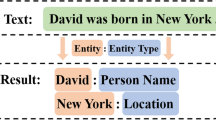Abstract
There are many levels in the task of information extraction. Level 1 deals with named entities such as PERSON, ORG, DATE, etc. Level 2 concerns the role played by the named entities wrt a specific event. For instance, in a management change event, a PERSON might be either the new coming person to the company or the leaving one. Building learning models for event extraction without considering the different levels is completely misleading. In this paper, the reasons for considering these levels are explained, and an adaptive model for event extraction is proposed. It could be applied on any sequence labeleling system, e.g., CRF-based classifier, RNN, LSTM, etc. The experimental results show that the adaptive model outperforms the direct model in terms of efficiency and gives comparable results compared to GLA2E, an expert’s pattern based event extractor.










Similar content being viewed by others
Notes
Available athttps://www.aclweb.org/portal/content/text-analysis-conference-2 (acceded Dec. 2017)
Available athttps://babelnet.org (acceded Dec. 2017)
Available athttps://www.wikipedia.org/ (acceded Dec. 2017)
Available athttps://www.depends-on-the-definition.com (October. 2018)
References
Besanċon R, De Chalendar G, Ferret O, Gara F, Mesnard O, Laïb M, Semmar N (2010) Lima: a multilingual framework for linguistic analysis and linguistic resources development and evaluation. In: Proceedings of the seventh conference on international language resources and evaluation (LREC’10). Valletta
Bikel DM, Schwartz R, Weischedel RM (1999) An algorithm that learns what’s in a name. Mach Learn 34(1):211–231
Borthwick A, Grishman R (1999) A maximum entropy approach to named entity recognition. Ph.D. thesis, New York University Graduate School of Arts and Science
Breiman L (2001) Random forests. Mach Learn 45(1):5–32
Bunescu RC, Pasca M (2006) Using encyclopedic knowledge for named entity disambiguation. In: Eacl, vol 6, pp 9–16
Burke E, Wada A, Coe B (2017) Electronic document information extraction. US Patent 9,547,648
Carreras X, Màrquez L, Padró L (2003) A simple named entity extractor using adaboost. In: Proceedings of the seventh conference on natural language learning at HLT-NAACL 2003, vol 4. Association for Computational Linguistics, pp 152–155
Chieu HL, Ng HT (2002) Named entity recognition: a maximum entropy approach using global information. In: Proceedings of the 19th international conference on computational linguistics, vol 1. Association for Computational Linguistics, pp 1–7
Dietterich T (2002) Machine learning for sequential data: a review. Structural, Syntactic, and Statistical Pattern Recognition, 227–246
Ekbal A, Bandyopadhyay S (2010) Named entity recognition using support vector machine: a language independent approach. Int J Electric Comput Syst Eng 4 (2):155–170
Elloumi S, Jaoua A, Ferjani F, Semmar N, Besanson R, Jaam J, Hammami H (2012) General learning approach for event extraction: case of management change event. Journal of Information Science (JIS) 39:211–224. https://doi.org/10.1177/0165551512464140
Feng X, Qin B, Liu T (2018) A language-independent neural network for event detection. Sci Chin Inf Sci 61(9):092,106
Finkel JR, Grenager T, Manning C (2005) Incorporating non-local information into information extraction systems by Gibbs sampling. In: Proceedings of the 43rd annual meeting on association for computational linguistics. Association for Computational Linguistics, pp 363–370
Goller C, Kuchler A (1996) Learning task-dependent distributed representations by backpropagation through structure. Neural Netw 1:347–352
Grishman R, Sundheim B (1996) Message understanding conference-6: a brief history. In: Proceedings of the 16th conference on computational linguistics - volume 1, COLING ’96. Association for Computational Linguistics, Stroudsburg, pp 466–471, https://doi.org/10.3115/992628.992709
Hochreiter S, Schmidhuber J (1997) Long short-term memory. Neur Comput 9(8):1735–1780
Huang Z, Xu W, Yu K (2015) Bidirectional lstm-crf models for sequence tagging. arXiv:1508.01991
Huffman S (1996) Connectionist, statistical, and symbolic approaches to learning for natural language processing chapter learning information extraction patterns from examples
Isozaki H, Kazawa H (2002) Efficient support vector classifiers for named entity recognition. In: Proceedings of the 19th international conference on computational linguistics, vol 1. Association for Computational Linguistics, pp 1–7
Jaoua A, Jaam J, Hammami H, Ferjani F, Laban F, Semmar N, Essafi H, Elloumi S (2010) Financial events detection by conceptual news categorization. In: Proceedings of the international conference on intelligent systems design and applications (ISDA’2010). Cairo, pp 1101–1106
Kazama J, Torisawa K (2007) Exploiting wikipedia as external knowledge for named entity recognition. In: Proceedings of the 2007 joint conference on empirical methods in natural language processing and computational natural language learning (EMNLP-CoNLL), pp 698–707
Laerty J, McCallum A, Pereira F (2001) Conditional random fields: probabilistic models for segmenting and labeling sequence data. In: Proceedings of ICML
Liu H, Yang Z, Wu Z, et al. (2011) Locality-constrained concept factorization. In: IJCAI Proceedings-international joint conference on artificial intelligence, vol 22, p 1378
Ma X, Hovy E (2016) End-to-end sequence labeling via bi-directional lstm-cnns-crf. arXiv:1603.01354
McCallum A, Li W (2003) Early results for named entity recognition with conditional random fields, feature induction and web-enhanced lexicons. In: Proceedings of the seventh conference on natural language learning at HLT-NAACL 2003, vol 4. Association for Computational Linguistics, pp 188–191
McCallum A, Freitag D, Pereira FC (2000) Maximum entropy Markov models for information extraction and segmentation. In: Icml, vol 17, pp 591–598
Mooney RJ, Bunescu RC (2006) Subsequence kernels for relation extraction. In: Advances in neural information processing systems, pp 171–178
Ramshaw LA, Marcus MP (1999) Text chunking using transformation-based learning. In: Natural language processing using very large corpora. Springer, pp 157–176
Richman AE, Schone P (2008) Mining wiki resources for multilingual named entity recognition. In: ACL, pp 1–9
Rodriguez-Esteban R (2017) Text mining applications. In: Reference module in life sciences. Elsevier. https://doi.org/10.1016/B978-0-12-809633-8.12372-6
Sekine S, Grishman R, Shinnou H (1998) A decision tree method for finding and classifying names in Japanese texts. In: Proceedings of the sixth workshop on very large corpora
Yan W, Zhang B, Ma S, Yang Z (2017) A novel regularized concept factorization for document clustering. Knowl-Based Syst 135:147–158
Author information
Authors and Affiliations
Corresponding author
Additional information
Publisher’s note
Springer Nature remains neutral with regard to jurisdictional claims in published maps and institutional affiliations.
Rights and permissions
About this article
Cite this article
Elloumi, S. An adaptive model for sequential labeling systems. Multimed Tools Appl 78, 22183–22197 (2019). https://doi.org/10.1007/s11042-019-7558-8
Received:
Revised:
Accepted:
Published:
Issue Date:
DOI: https://doi.org/10.1007/s11042-019-7558-8




